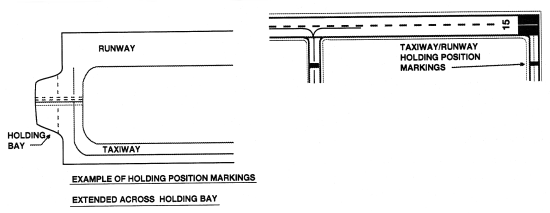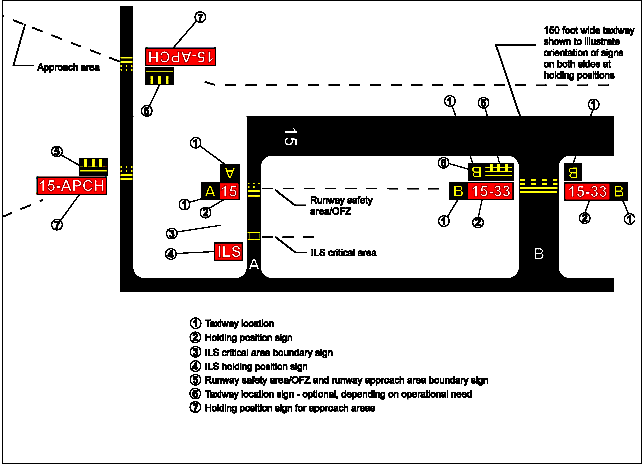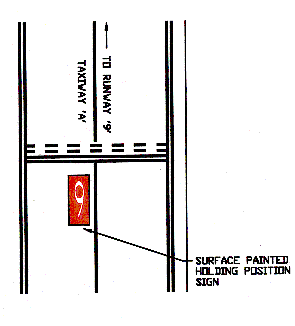Runway Holding Position Markings
Runway holding position markings consist of four yellow lines, two solid and two dashed, which extend across the width of the taxiway or runway to indicate where the aircraft is to be stopped when approaching a runway. You will need to remember that the two solid lines are on the taxiway side of the hold position marking, while the two dashed lines are on the runway side. In other words, when approaching a hold position marking from the side with continuous lines, the pilot should not cross the line without an air traffic control clearance.
Runway holding position markings are placed on a taxiway to indicate where an aircraft is to stop when it does not have clearance to proceed onto or across the runway. For aircraft approaching a runway, the pilot must ensure that no portion of the aircraft extends beyond these runway holding position markings until the aircraft is properly cleared onto or across the runway. For aircraft exiting the runway, the pilot is not clear of the runway until every part of the airplane has crossed the runway holding position marking.
Runway holding position markings are also placed prior to runway intersections. This allows the air traffic controller to utilize land and hold short operations at their airport, in which an aircraft is cleared to land on one runway but instructed to hold short of another. Air traffic control might also issue a clearance to an aircraft to taxi down a runway but hold short of another. The holding position markings are placed on the runways prior to the intersection with another runway, or at some designated point on the runway. A sign is used with these markings to aid pilots in identifying the holding position. The sign has a white inscription on a red background and is installed adjacent to the runway holding position markings. When instructed to hold short of a runway intersection, no portion of the aircraft may extend beyond these markings.
One holding position marking that routinely confuses pilots of all experience levels is the holding position marking placed on a taxiway to protect runway approach areas. The marking often confuses pilots because it gives the look and feel that you are crossing the runway hold short line, which protects the runway itself. However, this runway holding position marking is used to protect a runway approach or departure area. It is used to protect operations on a particular runway from taxiing aircraft. The approach hold short line is distinguished from the runway hold short line by a colocated sign. This sign has a white inscription on a red background, stating "APCH". If air traffic control desires you to hold short at the approach hold short line, they will state "Hold short of runway XX approach area". In this case, no portion of the aircraft may extend beyond the approach hold short position marking. If ATC instructs you to "Hold short of runway XX" or "Taxi to runway XX", then you may bypass the runway approach area hold position markings and continue so that no portion of the aircraft extends beyond the runway hold position markings. Pilots often become concerned or confused and decide to unnecessarily hold short of the approach area. If you're confused, this is certainly the wiser choice. Stop and verify with the control tower if you are uncertain where to hold short.
Holding Position Markings for an Instrument Landing System (ILS)
The instrument landing system broadcasts signals to arriving instrument aircraft to guide them to the runway. Each of these ILS systems has a critical area that must be kept clear of all vehicles in order to ensure quality of the broadcast signal. At many airports, taxiways extend into the ILS critical area. Most of the time, this is of no concern. However, during times of poorer weather, an aircraft on approach may depend on good signal quality. When necessary, air traffic control will protect the ILS critical area for arrival instrument traffic by instructing taxiing aircraft to hold short of this critical area.
Holding position markings for ILS critical areas consist of two yellow solid lines spaced two feet apart connected by pairs of solid lines spaced ten feet apart extending across the width of the taxiway. When instructed to hold short of the ILS critical area, the pilot must ensure no portion of the aircraft extends beyond these markings.
Holding Position Markings for Taxiway/Taxiway Intersections
Holding position markings are used to protect taxiway intersections consist of a single dashed line extending across the width of the taxiway. When instructed by the tower to "hold short of taxiway (designation)" the pilot must ensure no portion of the aircraft extends beyond these markings. At some airports, the tower might give the instruction to hold short of a taxiway which does not bear this hold short marking. If the marking is not present, then the pilot is to use good judgment in determining a stopping point which provides adequate clearance for the aircraft on the intersecting taxiway.
Surface Painted Position Signs
Surface painted holding position signs may be used to aid pilots in determining the holding position. These signs consist of a white inscription on a red background painted on the left side of the taxiway centerline. These markings are used to supplement the holding position signs, which are located adjacent to the holding position.




